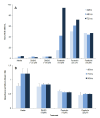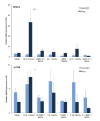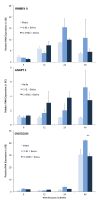Optimization of BeWo model to investigate placental responses to Plasmodium falciparum infected erythrocytes
- PMID: 38596773
- PMCID: PMC11003213
- DOI: 10.5281/zenodo.10757455
Optimization of BeWo model to investigate placental responses to Plasmodium falciparum infected erythrocytes
Abstract
Background: Establishment of an in vitro model to study placental malaria is essential for understanding the biology and pathogenesis of placental malaria. We defined experimental variables for obtaining responses of BeWo cells to placental binding Plasmodium falciparum infected erythrocytes (IE, CS2 parasites).
Materials and methods: Experimental variables included i) concentration of forskolin, a cyclic adenosine monophosphate inducer important in the induction of syncytialisation of BeWo, ii) suitable period of incubating BeWo with forskolin, and iii) ratio of IE to BeWo cells and length of incubation to induce physiological changes in BeWo cells, including the vasculogenic factors vascular endothelial growth factor A (VEGFA), endoglin, and angiopoietin-2; an anti-angiogenic factor (inhibin A); a regulator of cell growth, mammalian target of rapamycin (mTOR); a chemokine (IL-8); and the cytokine macrophage inhibition factor. The human hormone, chorionic gonadotrophin was used as a marker for syncytialisation.
Results: We showed that 72 hrs incubation of BeWo with 10 μm forskolin resulted in higher levels of syncytialisation and hCG secretion. Overall, the best condition was to co-culture syncytialised BeWo with a 10:1 ratio of IE for 48 hours. Under these conditions, when co-cultured with IE, BeWo produced increased amounts of IL-8 (p=0.0001), VEGF (p=0.001) and endoglin (p=0.001).
Conclusion: The model can be used to evaluate the impact of IE, inflammatory cytokines and other factors associated with placental malaria on syncytiotrophoblast function.
Copyright © 2017 Kidima et al.
Conflict of interest statement
The authors declare that they have no competing interests.
Figures






References
-
- Magistrado P, Salanti A, Tuikue Ndam NG, Mwakalinga SB et al. VAR2CSA expression on the surface of placenta-derived Plasmodium falciparum-infected erythrocytes. J. Infect. Dis. 2008;198:1071–1074. - PubMed
-
- Gamain B, Smith JD, Viebig NK, Gysin J et al. Pregnancy -associated malaria : Parasite binding, natural immunity and vaccine development. Int. J. Parasitol. 2007;37:273283. - PubMed
-
- Sullivan AD, Nyirenda T, Cullinan T, Taylor T et al. Malaria infection during pregnancy: intrauterine growth retardation and preterm delivery in Malawi. J. Infect. Dis. 1999;179:1580–1583. - PubMed
LinkOut - more resources
Full Text Sources
Miscellaneous
